Plants That Eat Food
At 5 a.m. we came to a stop at the sea-ice edge about 10 miles north of McMurdo Station. A single emperor penguin was asleep about a quarter-mile away, its head tucked snugly out of sight. In the patch of open water our ship had created, a minke whale surfaced. Underneath the ice plain before us, far stranger organisms were living a double life.
The ship’s crane picked up a curious contraption of rope webbing with a rubber-disc floor. It looked like something you might use to hang a giant houseplant, except it had three scientists, a generator, and an electric drill on it. The crane’s arm swung over the side of the Palmer and gently deposited the people onto the sea ice—the first time they’d been off the ship in 12 days. Three more trips of scientists and equipment followed. Read on through the slideshow to find out what they were doing:
- With so much sea ice around us, the temperature had dropped to about 15° Fahrenheit, and a 20-mph wind made it even colder. The scientists put on layers of fleece and covered up with bright-red, one-piece Mustang suits. Graduate student Elizabeth Halliday said she put on both pairs of thick socks she had been issued in Christchurch—and could no longer fit her feet into her ship shoes.
- The marine technicians call this contraption a bucket, but it’s really just a round platform with some rope to clip a safety belt onto. The ship’s crane carries the scientists across the water and drops them onto the ice while a marine tech holds a safety line. When the ice is brittle, this procedure is simpler and safer than trying to lower a ramp onto the ice and walk on.
- The first thing to do when you get on a plain of floating sea ice with a thin covering of snow is probe for cracks. We walked slowly and used the metal pole to check that our footing was solid.
- We had come to the sea ice so a team led by Dr. Rebecca Gast of Woods Hole Oceanographic Institution and Dr. Bob Sanders of Temple University could look for strange, single-celled creatures that live in the ice. They can make food from sunlight, like plants, but they also eat things, like animals do. ‘They’re oddities,’ Dr. Gast said. ‘I like them because they do things that fall outside of what normal cells do.’ To find them, she’ll need a big, drill-operated ice auger.
- The sea ice here is about 6 feet thick and takes two people to drill through. It is frozen in a continuous sheet all the way to the land on either side of McMurdo Sound—a stretch of about 30 miles. In nautical terms, this kind of sea ice is called fast ice. It comes from the sailor’s term ‘fast,’ which means fixed and unmovable.
- Up comes an ice core, held inside the hollow tube of the auger. Though all we can see around us is flat, sterile, and white, the ice’s underside is slushy and brown with living organisms. The creatures the science team is looking for are small—less than 20 microns across. You could fit about five of the biggest ones widthwise across a hair.
- Dr. Sanders slides the ice core onto a pipe cradle for sampling. Dr. Scott Fay (center) of Temple University will cut a 4-inch section from the center using a hand saw, and Elizabeth (right) will store it in a plastic bag and record data about it.
- The single-celled organisms the team is looking for are called ‘mixotrophs,’ meaning ‘mixed feeding.’ They carry chlorophyll and conduct photosynthesis but they also have the machinery to capture smaller items such as bacteria and consume them. Even though this core looks clear, it probably has phytoplankton and mixotrophs living in it. Once you look for them, Dr. Sanders said, you find them all over the world.
- Meanwhile, 100 yards away, the glider team were trying to fix the faulty compass on their glider. They needed to get away from the ship and the volcanic rock of Ross Island, both of which distort compass readings. Going out on the sea ice is a good trick—in fact, it’s one that Captain James Clark Ross used in these same waters back in 1841.
- To calibrate the compass the team has to level the glider and then point it perfectly north, then perfectly south, and finally turn the glider upside down. Dr. Josh Kohut of Rutgers University sights for north with his compass and tells Jullie Jackson, Ana Filipa Carvalho, and Eli Hunter which way to turn the glider. Eli has his laptop set up on the table so he can see the readings from the glider’s compass.
- Drifts of snow up to a foot deep had collected behind ridges in the ice. On the way back to the ship, Dr. Gast took the opportunity to demonstrate her flawless snow angel technique. Look closely and you can see the outline.
- Back in the Palmer’s cold lab, Dr. Sanders and Dr. Gast crush the ice samples and then wash them with filtered seawater. The organisms live inside channels of salty water that run through the ice. Very little is known about how much these mixotrophs eat or how many species there are. But they can be so common that they may have a large effect on the availability of food and nutrients around them. Dr. Sanders has studied these creatures for 25 years. ‘As a young graduate student I just thought it was cool that there were plants that could eat food,’ he said. ‘And I still do.’


 January 30, 2011
January 30, 2011 
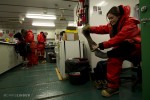
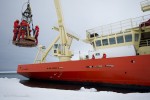
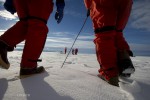
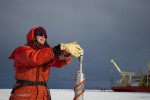
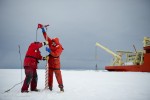
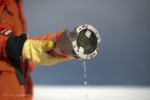
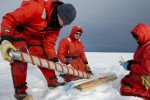
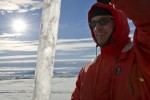
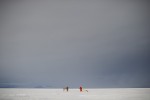
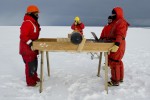
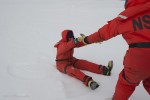
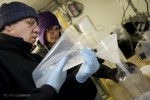







33 Responses to “Plants That Eat Food”